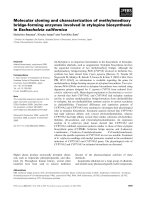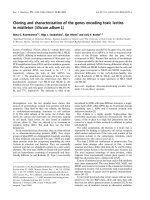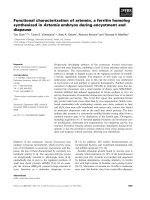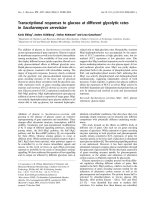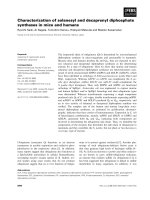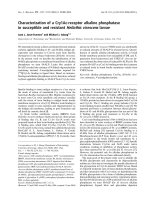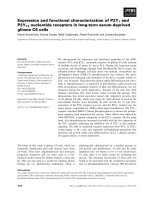Characterization of adiponectin at different physiological states in cattle based on an in house developed immunological assay for bovine adiponectin
Bạn đang xem bản rút gọn của tài liệu. Xem và tải ngay bản đầy đủ của tài liệu tại đây (2.23 MB, 139 trang )
Institut für Tierwissenschaften
Abteilung Physiologie und Hygiene
der Rheinischen Friedrich-Wilhelms-Universität Bonn
Characterization of adiponectin at different physiological states in
cattle based on an in-house developed immunological assay for
bovine adiponectin
Inaugural - Dissertation
zur
Erlangung des Grades
Doktor der Agrarwissenschaften
(Dr. agr.)
der
Landwirtschaftlichen Fakultät
der
Rheinischen Friedrich-Wilhelms-Universität Bonn
von
M.V.Sc. Shiva Pratap Singh
aus
Bulandshahar, Indien
Referentin:
Prof. Dr. Dr. Helga Sauerwein
Korreferent:
Prof. Dr. Karl-Heinz Südekum
Tag der mündlichen Prüfung:
24.01.2014
Erscheinungsjahr:
2014
Dedicated to my family
I
Abstract
Adipose tissue (AT), through secretion of adipokines, plays a central role in regulating
metabolism. Adiponectin is one of the most abundant adipokines and is linked with
several physiological mechanisms such as insulin sensitivity and inflammation. The aim
of this dissertation was to characterize the effect of stage of lactation and of
supplementation with conjugated linoleic acids (CLA) on blood adiponectin in dairy
cows. In addition, adiponectin concentrations in different AT depots and the effect of
lactational and dietary induced negative energy balance (NEB) on blood and milk
adiponectin were studied in dairy cows. Adiponectin concentrations of blood were
studied using serum samples obtained from multiparous (MP) and primiparous (PP)
cows receiving either CLA or a control fat supplement from d -21 to d 252 relative to
calving, and serum as well as AT samples [3 subcutaneous (sc): tail-head, sternum and
withers and 3 visceral (vc): mesenterial, omental and retroperitoneal] from PP cows
slaughtered at d 1, 42 and 105 of lactation. Effects of lactational and dietary induced
NEB on plasma adiponectin were investigated in MP cows from d -21 to d 182 relative
to calving with feed restriction for 3 weeks beginning at around 100 days of lactation.
Blood adiponectin was decreased from d 21 ante partum, reached a nadir at calving and
increased during the post partum period. CLA supplementation reduced circulating
adiponectin post partum in both MP and PP cows and, as indicated by a surrogate
marker of insulin sensitivity (RQUICKI) also resulted in decreased insulin sensitivity.
The decline in blood adiponectin around parturition may result from reduced
adiponectin protein expression in all fat depots. vcAT contained more adiponectin than
scAT suggesting a relatively higher impact of vcAT on adiponectin blood
concentrations. However, retroperitoneal AT had the lowest adiponectin content
compared to the other fat depots and thus seems to play an unique role in lipid
mobilization in dairy cows. NEB due to feed restriction about 100 days of lactation
caused a decline in adiponectin secretion through milk but did not affect its plasma
concentrations. In conclusion, the major changes in blood adiponectin occurred around
parturition; dietary CLA supplementation reduced circulating adiponectin. Differing
amounts of adiponectin per AT depot indicate differential contributions to circulating
adiponectin. The present dissertation serves as a basis for further studies elucidating the
role and regulation of adiponectin and other adipokines in various pathophysiological
conditions in cattle.
II
Abstrakt
Fettgewebe spielt über die Sekretion von Adipokinen eine zentrale Rolle in der Regulation des
Stoffwechsels. Adiponektin ist eines der am häufigsten vorkommenden Adipokine und ist mit
verschiedenen physiologischen Prozessen wie Insulinsensitivität und Entzündungsreaktionen
verbunden. Ziel der vorliegenden Dissertation war es, die Effekte des Laktationstadiums sowie
einer Supplementation mit konjugierten Linolsäuren (CLA) auf den Blutspiegel von
Adiponektin
bei
Milchkühen
zu
charakterisieren.
Des
Weiteren
wurde
die
Adiponektinkonzentration in verschiedenen Fettdepots von Milchkühen ermittelt, sowie die
Effekte von sowohl laktationsbedingter als auch fütterungsinduzierter negativer Energiebilanz
(NEB) auf die Adiponektinkonzentration im Blut und in der Milch untersucht. Die Bestimmung
der Adiponektinkonzentration erfolgte im Blut multiparer (MP) und primiparer (PP) Kühe,
welche entweder mit CLA oder einem Kontrollfett gefüttert wurden im Zeitraum von Tag -21
bis Tag 252 relativ zur Kalbung. In einem weiteren Versuch wurde Adiponektin in Serum, und
Fettgewebe [3 subkutane (sc) Depots: Schwanzansatz, Sternum und Widerrist, und 3 viszerale
(vc) Depots: mesenterial, omental und retroperitoneal] bei PP Kühen gemessen, die an Tag 1, 42
und 105 während der Laktation geschlachtet wurden. Die Effekte einer laktationsbedingten
sowie einer fütterungsinduzierten NEB auf die Plasmadiponektinkonzentration wurden in MP
Kühen zwischen Tag 21 vor der Kalbung bis Tag 185 der Laktation untersucht. Die restriktive
Fütterung erfolgte über einen Zeitraum von drei Wochen, beginnend an Tag 100 der Laktation.
Die Adiponektinkonzentration im Blut sank von Tag 21 ante partum, erreichte ihren niedrigsten
Wert zum Zeitpunkt der Kalbung und stieg im postpartalen Zeitraum wieder an. Die CLASupplementation führte sowohl bei MP als auch bei PP Kühen zu einer Reduktion der
zirkulierenden Adiponektinkonzentration post partum und weißt zudem über einen Marker für
Insulinsensitivität (RQUICKI) auf eine verminderte Insulinsensitivität hin. Der Abfall der
Adiponektinkonzentration im Blut um den Zeitraum der Geburt könnte durch eine verringerte
Adiponektin-Proteinexpression in den
Fettdepots induziert sein. Das viszerale Fettgewebe
enthielt mehr Adiponektin als das subkutane Fettgewebe, was einen relativ größeren Einfluss
der viszeralen Depots auf die Blutadiponektinkonzentration vermuten lässt. Das retroperitoneale
Fettgewebe wies aber, verglichen mit den anderen Depots, den geringsten Adiponektingehalt
auf und scheint deswegen eine besondere Rolle in der Lipidmobilisation von Milchkühen zu
spielen. Die fütterungsbedingte NEB im Zeitraum um Tag 100 der Laktation führte zu einer
Abnahme der Adiponektinsekretion durch die Milch, beeinflusste jedoch nicht die
Plasmakonzentrationen. Zusammenfassend zeigte sich, dass die größten Veränderungen der
Adiponektinblutkonzentration im Zeitraum um die Geburt auftraten und das zirkulierende
Adiponektin durch die CLA-Supplementation reduziert wurde. Die unterschiedlichen Gehalte
der einzelnen Fettdepots weisen auf unterschiedliche Beiträge der Gewebe zur zirkulierenden
Adiponektinkonzentration hin. Die vorliegende Dissertation stellt eine Basis für weiterführende
Studien dar, um die Rolle und Regulation von Adiponektin sowie anderer Adipokine in
verschiedenen pathophysiologischen Zuständen von Rindern zu klären.
III
Table of contents
Contents
Page no.
Abstract ………………………………………….........................................
I
Abstrakt ………………………………………….........................................
II
List of abbreviations ………………………………………….....................
V
List of tables ………………………………………….................................
VII
List of figures …………………………………………...............................
IX
1. Introduction
1.1. Physiological role of adipose tissue in transition period and
lactation in dairy cows …………………………………………............
1
1.1.1. Adipose tissue ……………………………………………..
2
1.1.2. Subcutaneous and visceral adipose tissue ………………...
3
1.2. Adipokines
1.2.1. Adiponectin and adiponectin receptors …………………...
5
1.2.2. Adiponectin, insulin sensitivity and nutrient partitioning…
8
1.3. Conjugated linoleic acids (CLA)
1.3.1. Effect of CLA on feed intake and energy balance ………..
12
1.3.2. Metabolic functions of CLA ………………………............
12
1.3.3. Role of CLA in adiponectin expression …………………..
14
1.4. Enzyme-linked immunosorbent assay for bovine adiponectin
1.4.1. Principle of the ELISA for bovine adiponectin …………...
15
1.5. Objectives …………………………………………………............
17
2. Manuscript 1: Supplementation with conjugated linoleic acids extends
the adiponectin deficit during early lactation in dairy cows ………………
18
3. Manuscript 2: Lactation driven dynamics of adiponectin supply from
different fat depots to circulation in cows …………………………………
49
IV
4. Manuscript 3: Short communication: Circulating and milk adiponectin
change differently during energy deficiency at different stages of lactation
in dairy cows.........................................................................................
77
5. General discussion and future research prospectives..............................
95
6. Summary..................................................................................................
98
7. Zusammenfassung ………………………………………………………
101
8. References ………………………………………………………………
104
9. Appendixes …………………………………………………………….
117
10. Acknowledgments……………………………………………………...
121
11. Publications derived from this doctorate thesis and related works
11.1. Papers and manuscripts...............................................................
123
11.2. Abstracts in conferences..............................................................
124
V
List of abbreviations
Approx.
approximately
AT
adipose tissue
AdipoQ
adiponectin
AdipoR1
adiponectin receptor R1
AdipoR2
adiponectin receptor R2
ANOVA
analysis of variance
a.p.
ante partum
B0
absorbance of the maximum binding well
B/B0 (%)
percent maximum binding
BCS
body condition score
BFT
back fat thickness
BHBA
ß-hydroxybutyrate
BW
body weight
c-9, t-11
cis-9, trans-11
CLA
conjugated linoleic acid
CON
control
CP
crude protein
d
day
DIM
day(s) in milk
DM
dry matter
EBW
empty body weight
EDTA
ethylenediaminetetraacetic acid
ELISA
enzyme-linked immunosorbent assay
FA
fatty acids
FLI
Friedrich-Loeffler-Institute
GfE
German Society of Nutrition Physiology
GLM
general linear model
HF
Holstein-Friesian
Hp
haptoglobin
HSL
hormone sensitive lipase
IGF-1
insulin-like growth factor-1
VI
IL
interleukin
IS
insulin sensitivity
IR
insulin resistance
LAVES
Lower Saxony State Office for Consumer Protection and Food
Safety
LPL
lipoprotein lipase
mAb
monoclonal antibodies
ME
metabolizable energy
MP
multiparous
NEB
negative energy balance
NEFA
nonesterified fatty acids
NF-κB
nuclear factor-kappa B
PP
primiparous
p.p.
post partum
PMR
partial mixed ration
PPAR
peroxisome proliferator-activated receptor
r
Pearson correlation coefficient
ρ
Spearman correlation coefficient
RQUICKI
revised quantitative insulin sensitivity check index
RT
room temperature
sc
subcutaneous
SCC
somatic cell count
SEM
standard error of the means
TAG
triacylglycerides
TNF-α
tumor necrosis factor-alpha
t-10, c-12
trans-10, cis-12
vc
visceral
VEGF
vascular endothelial growth factor
WAT
white adipose tissue
VII
List of tables
Tables
Page no.
Introduction
Table 1
Differences in functional properties of subcutaneous
adipose tissue (scAT) and visceral adipose tissue
(vcAT) in humans, rats and dairy cows.……………….
Table 2
Influences of hormones and cytokines on adiponectin
mRNA or protein expression in adipose tissue.……….
Table 3
4
10
Effects of CLA on dry matter intake (DMI) and post
partum negative energy balance (NEB) in dairy cows....
12
Manuscript 1
Table 1
Pearson
correlation
coefficients
of
adiponectin
(µg/mL), leptin (ng/mL) and adiponectin : leptin ratio
(ALR) with blood variables ...........................................
Supplemental
P values for fixed factors and their interactions using
Table 1
linear mixed model for serum adiponectin during
different experiment periods.........................................
Supplemental
P values for fixed factors and their interactions using
Table 2
linear mixed model for serum adiponectin to leptin
ratio during different experiment periods.....................
42
43
44
Manuscript 2
Table 1
Pearson correlation coefficient between log serum
AdipoQ (µg/ml) and AT variables in dairy cows..........
Table 2
70
Relationships (Pearson correlation coefficients) of
adipocyte sizes (µm2) with log tissue AdipoQ
concentrations (ng/g tissue) and RQUICKI in dairy
cows..........................................................................
Table 3
71
Pearson correlation coefficient between log tissue
AdipoQ and log plasma IGF-1 (ng/mL) and log NEFA
(µEq/L) concentration in dairy cows...........................
71
VIII
Table 4
Pearson correlation coefficient between log tissue
AdipoQ concentration (ng/g tissue) and measures of
body condition in dairy cows.......................................
Table 5
72
Multiple linear regression analyses of the relationship
between adipose tissue depot measures with serum
AdipoQ concentration ………………………………....
72
Manuscript 3
Table 1
Pearson correlation
coefficients
between plasma
adiponectin (µg/mL) and plasma, milk and other
variables.……………………………………………….
Table 2
90
Pearson correlation coefficients of milk adiponectin
concentration (µg/mL) and milk adiponectin secretion
(mg/d) with milk, plasma and other variables...............
91
IX
List of figures
Figures
Page no.
Figure 1
Physiological functions affected by adipokines.………
3
Figure 2
Patho-physiological
Introduction
states
influencing
circulating
adiponectin concentration.……………………………
5
Figure 3
Structural features of adiponectin isoforms................
7
Figure 4
Insulin sensitizing and nutrient partitioning effects of
adiponectin.……………………………………………
Figure 5
Linoleic acid and major conjugated linoleic acids
(CLA) isomers.……………………………………….
Figure 6
14
Setup of in-house developed indirect competitive
bovine adiponectin ELISA ……………………………
Figure 8
11
Mechanisms associated with the effect of CLA on
adiponectin expression ………………………………..
Figure 7
9
16
Typical standard curve of the ELISA for bovine
adiponectin ……………………………………………
16
Manuscript 1
Figure 1
Serum adiponectin concentrations (means ± SEM) and
serum adiponectin leptin ratio (ALR) in multiparous
(MP) and primiparous (PP) cows receiving 100 g/d of
either conjugated linoleic acids (CLA) or a control fat
supplement (CON) from d 1 to d 182 post partum ……
Figure 2
45
Exemplary Western blot of adiponectin multimeric
isoforms [high molecular weight (HMW) and middle
molecular
weight
nonheat-denaturing
(MMW)]
conditions
under
with
nonreducing,
sera
from
multiparous (MP) or primiparous (PP) cows receiving
a control fat (CON) or conjugated linoleic acids (CLA)
on d 1 and d 105 post partum …………………………
Figure 3
Adiponectin concentrations (means ± SEM) in adipose
46
X
tissue (A) ng/mg total protein and (B) ng/g wet tissue
basis corrected for blood-derived adiponectin ………..
Supplemental
Circulating concentrations of glucose, NEFA and
Figure 1
insulin (means ± SEM) in multiparous (MP) and
46
primiparous (PP) cows receiving 100 g/d of either
conjugated linoleic acids (CLA) or a control fat
supplement (CON) from d 1 to d 182 postpartum ……
Supplemental
Revised Quantitative Insulin Sensitivity Check Index
Figure 2
(RQUICKI), circulating concentrations of leptin and
47
IGF-1 (means ± SEM) in multiparous (MP) and
primiparous (PP) cows receiving 100 g/d of either
conjugated linoleic acids (CLA) or a control fat
supplement (CON) from d 1 to d 182 postpartum …….
48
Manuscript 2
Figure 1
Representative
preparations
serial
of
dilution
visceral
curve
for
tissue
(retroperitoneal)
and
subcutaneous (tail-head) adipose tissue (AT) depots,
demonstrating parallelism with the standard curve.......
Figure 2
Time dependent changes in serum adiponectin
(AdipoQ)
concentrations
(µg/ml)
and
Revised
Quantitative Insulin Sensitivity Check Index..............
Figure 3
73
73
Tissue adiponectin (AdipoQ) concentration (ng/mg
total protein and ng/g wet tissue) in visceral and
subcutaneous adipose tissue (AT) depots in different
lactation periods i.e. after parturition [day (d) 1], d 42
and d 105..................................................................
Figure 4
(A) Amount of adiponectin (AdipoQ, µg) in different
visceral (retroperitoneal, mesenterial, omental) and
subcutaneous (sc) adipose tissue (AT) depots in
different lactation periods i.e. d 1, 42 and 105 after
parturition, (B) Time dependent changes in absolute
depot mass (kg) of visceral and subcutaneous (sc) AT
74
XI
depots in different lactation periods i.e. d 1, 42 and 105
after parturition ..............................................................
Figure 5
75
Portion (%) of circulating adiponectin (AdipoQ)
present in visceral (vc) (pooled for mesenterial,
omental
and
retroperitoneal
fat
depot)
and
subcutaneous (sc) (pooled for sternum, tail-head and
withers fat depot) adipose tissue (AT) depots in
different lactation periods i.e. after parturition [day (d)
1], d 42 and d 105......................................................
Figure 6
76
Exemplary Western blots of AdipoQ multimeric
isoforms under non reducing and non heat-denaturing
conditions in adipose tissue (AT) extracts and serum
on day (d) 1 (A), d 42 (B) and d 105 (C) of lactation ...
76
Manuscript 3
Figure 1
Plasma adiponectin concentration (µg/mL) in cows
during the experimental period 1 (from wk 3 ante
partum up to wk 12 post partum), period 2 (3 wk of
feed restriction, started at about 100 DIM), and period
3 (8 wk of realimentation)……………………..............
Figure 2
92
Skim milk concentrations of adiponectin (ng/mL) and
adiponectin secretion (mg/d) at wk 2 and wk 12 of
period 1 and control (C) and feed-restricted (R) groups
at wk 2 of period 2 …………………………………….
Figure 3
93
Portion of plasma adiponectin (%) secreted though
milk per day at wk 2 and wk 12 of period 1 and control
(C) and feed-restricted (R) groups at wk 2 of period 2..
94
Introduction
1
1. Introduction
Milk production of dairy cows has increased steadily based on a combination of several
factors such as improved management, better nutrition and intense genetic selection.
Selection of dairy cows directed towards higher milk production is often associated with
changes in the pattern of nutrient partitioning (Oltenacu and Broom, 2010), decline in
immune responses (Hoeben et al., 1997) and reproductive performance (Dobson et al.,
2007) as well as higher incidence of metabolic problems such as milk fever and ketosis
(Fleischer et al., 2001). Most of the metabolic diseases in dairy cows occur within the
first 2 wk of lactation (Goff and Horst, 1997) and may cause severe economic loss in
terms of reduced milk production, impaired fertility, extra-expenses for treatment and
prevention efforts, and increased culling rates. Special feeding practices might help to
minimize such economical losses and to achieve better animal health around calving
and lactation. For this purpose, the diet for early lactating cows should be formulated to
achieve rapid balancing of energy losses induced by milk secretion, faster adaptation of
rumen function to the lactation diet, and immunomodulation to enable adequate immune
functions (Goff and Horst, 1997). Feed supplements such as conjugated linoleic acids
(CLA) have been demonstrated to exert beneficial effects on the immune system in
humans (Song et al., 2005) and in animals such as mice (Yamasaki et al., 2003a) and
pigs (Moraes et al., 2012). Conjugated linoleic acids are also known to inhibit milk fat
synthesis in dairy cows, thus reducing the energy needed for milk production
(Baumgard et al., 2000, Peterson et al., 2002). Thus, dietary supplementation with CLA
might be a strategy to minimize the magnitude and duration of negative energy balance
(NEB) and to improve immunity in early lactating dairy cows.
1.1. Physiological role of adipose tissue during the transition period and in early
lactation of dairy cows
The transition period in dairy cows is defined as the period between 3 wk pre partum
until 3 wk post partum and is characterized by dramatic changes in the endocrine status
and energy balance of the animal (Grummer, 1995). Energy balance is the difference
between energy consumed and energy required (for maintenance, growth, production,
activity and fetal growth) (Grummer and Rastani, 2003). During the pre calving
transition period, the nutrient demand is increased to support the final phase of
conceptus growth and lactogenesis. This is accompanied by a gradual decline in feed
Introduction
2
intake, with the most dramatic decrease during the final wk before calving (Grummer,
1995). During the early post partum period, voluntary feed intake is not increasing as
fast as the energy demand for increased milk production, possibly resulting from
calving stress and change in nutrient density of the diet. Consequently, dairy cows enter
a state of NEB. In order to accomplish the increased energy demand during this period,
the homeorhetic drive necessitates mobilization of body reserves, in particular fat from
adipose tissue (AT). The rate and extent of AT mobilization depend on several factors
such as body condition at the time of calving, parity, milk production and composition
of diet (Komaragiri et al., 1998). Thus, AT plays a central regulatory role during the
period of increased energy demand such as late pregnancy and early lactation in dairy
cows.
1.1.1. Adipose tissue
Adipose tissue is a highly specialized loose connective tissue composed of adipocytes,
collagen fibers and other cells summarized as the stromal vascular fraction such as
preadipocytes, endothelial cells, fibroblasts, immune cells, blood vessels and nerves.
Over the past one and half decades, numerous studies aimed to understand the role of
AT in homeostatic and metabolic regulation (Deng and Scherer, 2010, Rajala and
Scherer, 2003, Rosen and Spiegelman, 2006, Yamauchi et al., 2002). In consequence,
our perception about AT has changed considerably. In addition to their ability to store
or mobilize triglycerides, adipocytes synthesize and release a wide variety of bioactive
molecules collectively termed as adipokines or adipocytokines. Examples of adipokines
include adiponectin, leptin, resistin, visfatin, apelin, chemerin, omentin. Adipokines
allow for the communication of AT with other organs of the body such as liver
(Moschen et al., 2012), heart (Cherian et al., 2012), muscles (Zhou et al., 2007), brain
(Bartness and Song, 2007), reproductive organs (Mitchell et al., 2005) as well as within
the AT (Karastergiou and Mohamed-Ali, 2010). Adipose tissue is thus involved in the
coordination
of
various
biological
processes
including
energy
metabolism,
neuroendocrine, cardiovascular, reproductive and immune functions through its
secretions via autocrine, paracrine and endocrine mechanisms (Figure 1).
Mammals have two main types of AT depending on their cellular structure and
functions i.e. brown AT and white AT. Brown AT is primarily present in newborns and
hibernating mammals, and is involved in the process of heat generation. White AT is
Introduction
3
the most abundant form of AT in adults and serves as a regulatory center for energy
metabolism. Based on its anatomical locations, white AT is broadly classified into
subcutaneous AT (scAT) and visceral AT (vcAT).
1.1.2. Subcutaneous and visceral AT
The scAT is located in the hypodermal layer of the skin, whereas the vcAT surrounds
the inner organs in the abdominal cavity and mediastinum. Deep and superficial layers
of scAT can be separated by the Fascia superficialis (Wajchenberg et al., 2002). Based
on its locations, vcAT is divided into three major depots, i.e. mesenterial fat (more
deeply buried around the intestines), omental fat (surround the intestines superficially),
and retroperitoneal fat (near the kidneys, at the dorsal side of the abdominal cavity)
(Wronska and Kmiec, 2012). Different AT depots (scAT and vcAT) display distinct
Introduction
4
structural and functional properties; these may contribute to their differential role in
physiological mechanisms (Table 1). The precise mechanism for the functional
heterogeneity among fat depots is unclear.
Table 1. Differences in functional properties of subcutaneous adipose tissue (scAT) and visceral
adipose tissue (vcAT) in humans, rats and dairy cows
Characteristics
scAT vs. vcAT
Reference
Responsiveness to caloric restriction
vcAT ˃ scAT
Li et al., 2003‡
Catecholamine induced lipolysis
vcAT ˃ scAT
Wajchenberg, 2000‡
Antilipolytic effects of insulin
scAT ˃ vcAT
Wajchenberg, 2000‡
Insulin stimulated glucose uptake
vcAT ˃ scAT
Metabolic activity and mitochondrial
respiration
vcAT ˃ scAT
Glucocorticoid and androgen receptors
vcAT ˃ scAT
Correlation with IS, diabetes type II,
atherosclerosis and metabolic risk
factors
vcAT ˃ scAT
Cefalu et al., 1995‡, Fox
et al., 2007‡, Kissebah,
1996‡
Expression of genes (HSL, ATGL)
and of proteins (AMPKα1) related to
lipolysis
RPAT ˃ scAT
Locher et al., 2012*,
Palou et al., 2009†
Expression of fatty-acid oxidation
related genes (PPARα, CPT1)
scAT ˃ RPAT
Palou et al., 2009†
Triglyceride turnover rate
RPAT ˃ scAT
Palou et al., 2009†
Adipocyte size
RP AT ˃ other vc
(mesenterial,
omental) and sc AT
Akter et al., 2011*
1. 2. Virtanen et al., 2002‡
3. 4.
5. 6. Kraunsoe et al., 2010‡
7. 8. Björntorp, 1995‡,
Rebuffe-Scrive et al.,
1985‡
Reports in *dairy cows, †rats, ‡humans. AMPKα1: Adenosine monophosphate-activated protein kinaseα1; ATGL, adipose triglyceride lipase; CPT1; carnitine palmitoyltransferase-1; HSL: hormone sensitive
lipase; IS: insulin sensitivity; PPARα/γ: Peroxisome proliferator-activated receptor-α/γ; RPAT:
retroperitoneal adipose tissue.
Introduction
5
1.2. Adipokines
Biologically active secretions of adipose tissue (adipokines) are diversified in terms of
their protein structure and functions and are known to act at the local
(autocrine/paracrine) and/or systemic (endocrine) level. They may be protein hormones
(e.g. leptin, adiponectin, resistin, visfatin), cytokines (e.g. TNF-α, IL-6), chemokines
(e.g. monocyte chemoattractant protein-1), proteins of the alternative complement
system (e.g. adipsin, complement factor B), binding proteins (e.g. retinol binding
protein), extracellular matrix proteins (e.g. monocyte chemotactic protein-1) or growth
factors (e.g. nerve growth factor, vascular endothelial growth factor). Metabolic
dysfunctions may partly result from an imbalance in the expression of pro- (e.g. leptin,
resistin, TNF-α) and anti-inflammatory (e.g. adiponectin) adipokines; therefore, an
adequate balance between different adipokines is crucial for determining homeostasis in
the body (Ouchi et al., 2011). Adiponectin is one of the most important adipokines
linked with several physiological mechanisms such as insulin sensitivity, immunity,
reproduction, cardiovascular functions (Figure 2).
1.2.1. Adiponectin and adiponectin receptors
Adiponectin was independently characterized in the mid 1990s by four different
research groups using distinct methods and was named as Acrp30 (adipocyte
Introduction
6
complement-related protein of 30 kDa) (Scherer et al., 1995), apM1 (adipose most
abundant gene transcript 1) (Maeda et al., 1996), adipoQ (Hu et al., 1996), and GBP28
(gelatin binding protein of 28 kDa) (Nakano et al., 1996). Adiponectin is a protein
hormone expressed by differentiated adipocytes with circulating concentrations in the
µg/mL range, thus accounting for approximately 0.01% of the total plasma protein
(Arita et al., 1999). The adiponectin monomer is a 30 kDa polypeptide of 247 amino
acids containing a N-terminal signal sequence, a variable domain, a collagen-like
domain, and a C-terminal globular domain (Figure 3). It shares strong sequence
homology with type VIII and X collagen and complement component C1q (Scherer et
al., 1995). Post-translational modifications such as hydroxylation and glycosylation of
the lysine residues within the collagenous domain are required for full activity of
adiponectin (Wang et al., 2002). In contrast to several other adipokines, the plasma
concentration of adiponectin is markedly reduced in visceral obesity (Goldstein and
Scalia, 2004).
Adiponectin secretion from adipocytes is regulated by the endoplasmic reticulum (ER)
proteins ERp44 and Ero1-Lalpha. Formation of the covalent bond between ERp44 and
the thiol group of Cys39 on adiponectin molecule allows for the intracellular retention
of adiponectin (thiol-mediated retention) while the disulfide bond formed between
ERp44 and Ero1-L alpha releases adiponectin from ERp44 and allows its secretion from
the adipocytes (Wang et al., 2007). Adiponectin is secreted from adipocytes as fulllength adiponectin in three major isoforms i.e. low molecular weight (LMW), medium
molecular weight (MMW) and high molecular weight (HMW) isoform (Figure 3) (Waki
et al., 2003). The half life of MMW and HMW in mice is 4.5 and 9 h, respectively;
neither MMW nor HMW are interconverted in circulation (Pajvani et al., 2003).
Proteolytic cleavage of adiponectin molecules results in a product containing a globular
head domain that still remains biologically active (Fruebis et al., 2001).
Three putative adiponectin receptors are identified so far, these are the adiponectin
receptor 1 (AdipoR1), adiponectin receptor 2 (AdipoR2) and T-cadherin. Predominant
expression of AdipoR1 and AdipoR2 has been observed in skeletal muscle and liver,
respectively (Yamauchi et al., 2003). Adiponectin receptors have different affinities to
the various adiponectin isoforms: AdipoR1 is a receptor for globular and full-length
adiponectin isoforms whereas AdipoR2 has a higher affinity for full-length adiponectin
isoforms than globular adiponectin (Kadowaki et al., 2006). Moreover, T-cadherin has
Introduction
7
been identified as a receptor for the MMW and HMW adiponectin but not for the LMW
or globular forms (Hug et al., 2004).
Introduction
8
1.2.2. Adiponectin, insulin sensitivity and nutrient partitioning
Decreased insulin sensitivity (IS) is the situation in which normal insulin concentrations
produce less biological response than expected. This might be due to changes in the
sensitivity (the amount of hormones required for a desired response) and/or
responsiveness (the maximal response to the hormone) of body tissues for insulin
(Kahn, 1978). Early lactation in high yielding dairy cows is characterized by decreased
IS in body tissues such as AT and muscle, thereby promoting mobilization of nonesterified fatty acids (NEFA), amino acids and sparing of glucose for increased nutrient
demand of mammary gland for milk production (Bell, 1995).
The role of adiponectin as an insulin sensitizing adipokine was first identified in mice
by three independent groups (Berg et al., 2001, Fruebis et al., 2001, Yamauchi et al.,
2001). Plasma adiponectin decreases with the decrease of IS in rhesus monkeys (Hotta
et al., 2001), in mice and in humans (Maeda et al., 2001). Moreover, positive
associations of plasma adiponectin concentration with IS and inverse relationships with
several components related to decline in IS, such as serum high-density lipoprotein
cholesterol, triglycerides and diastolic blood pressure are observed in humans
(Fernandez-Real et al., 2003, Matsubara et al., 2002). Adiponectin is known to stimulate
glucose uptake and fatty acid oxidation by myocytes as well as to decrease
gluconeogenesis in the liver thereby decreasing blood glucose concentrations
(Yamauchi et al., 2002). The insulin sensitizing effect of adiponectin is mainly through
inhibition of hepatic glucose production and increased fatty acid oxidation (Lihn et al.,
2005). The metabolic and insulin sensitizing effects of adiponectin have not been fully
explored in dairy cows.
Adiponectin inhibits lipolysis in humans and in mice (Qiao et al., 2011, Wedellova et
al., 2011); therefore, lowered adiponectin concentrations facilitate the rate of lipolysis.
The impact of adiponectin on IS and on metabolism of glucose and fatty acid
contributes to nutrient partioning and thus may affect the nutrient availability in the
mammary gland for milk production (Figure 4). Certain pathological conditions such as
inflammation and endocrine hormones may affect the expression of adiponectin in AT.
The regulation of adiponectin expression through other hormones and cytokines are
summarized in Table 2.
Introduction
9
Introduction
10
Table 2. Influences of hormones and cytokines on adiponectin mRNA or protein expression in
adipose tissue
Hormone/cytokine
Cell type
Effect
Reference
Insulin
epididymal primary
adipocytes
↑ protein
Cong et al., 2007†
omental adipocytes
↑ protein
3T3L1 cells
↓ mRNA
perirenal and epididymal
adipocytes
↓ mRNA
Motoshima et al.,
2002‡
Fasshauer et al.,
2002
Sun et al., 2009*
sc adipocytes
↓ protein
3T3L1 cells
↓ mRNA
Degawa-Yamauchi
et al., 2005‡
Fasshauer et al.,
2002
Prolactin
sc abdominal
adipocytes
↓ mRNA, protein
Nilsson et al., 2005‡
Growth hormone
sc abdominal adipocytes
↓ mRNA, protein
Nilsson et al., 2005‡
Testosterone
SGBS adipocytes
NE mRNA, protein
3T3L1 cells
↓ mRNA, protein
Horenburg et al.,
2008‡
Nishizawa et al.,
2002# Li et al., 2011#
Progesterone
inguinal adipocytes
Estradiol
SGBS adipocytes
↓ mRNA (female)
NE (male)
NE mRNA, protein
Stelmanska et al.,
2012#
Horenburg et al.,
2008‡
DHE
omental adipocytes
↑ mRNA
Hernandez-Morante
et al., 2006‡
TNF-α
sc abdominal adipocytes
sc or omental adipocytes
↓ mRNA
↓ protein
3T3L1 cells
↓ mRNA
Bruun et al., 2003‡
Degawa-Yamauchi
et al., 2005‡
Fasshauer et al.,
2002; Ruan et al.,
2002
IL-6
sc abdominal adipocytes
↓ mRNA
Bruun et al., 2003‡
C- reactive protein
3T3L1 cells
↓ mRNA
Yuan et al., 2007
Glucocorticoids
Reports in *dairy cows, #mice, †rats, ‡humans; NE: no effect; sc: subcutaneous; DHE:
dehydroepiandrosterone; TNF-α: tumor necrosis factor-α, IL-6: interleukin-6; SGBS: human preadipocyte
cell line.
Introduction
11
1.3. Conjugated linoleic acids (CLA)
The term conjugated linoleic acids (CLA) refers to a heterogeneous group of positional
and geometric isomers of one of the omega-6 fatty acids, i.e. linoleic acid (cis-9, cis-12,
octadecadienoic acid) (Figure 5). Based on the positioning of the double bond, 28
isomers of CLA are possible, however, cis-9, trans-11 and trans-10, cis-12 CLA are the
most common CLA isomers in the commercially available CLA preparations (Banni,
2002). Cis-9, trans-11 is the major CLA isomer in ruminant fat (~75–90% of total CLA)
(Bauman et al., 2008). Dairy cows are able to synthesize the cis-9, trans-11 isomer
endogenously by two different biosynthetic processes: First, as an intermediate product
of biohydrogenation of linoleic acid by ruminal bacteria i.e. Butyrivibrio fibrisolvens
(Kepler et al., 1966), and second, by desaturation of trans-11 C18:1 (vaccenic acid),
another intermediate in the biohydrogenation of unsaturated fatty acids, by the ∆9desaturase enzyme in body tissues such as AT and mammary gland (Bauman et al.,
1999). Details about the metabolic functions of CLA and their role in adiponectin
expression are given in following sub-sections.

